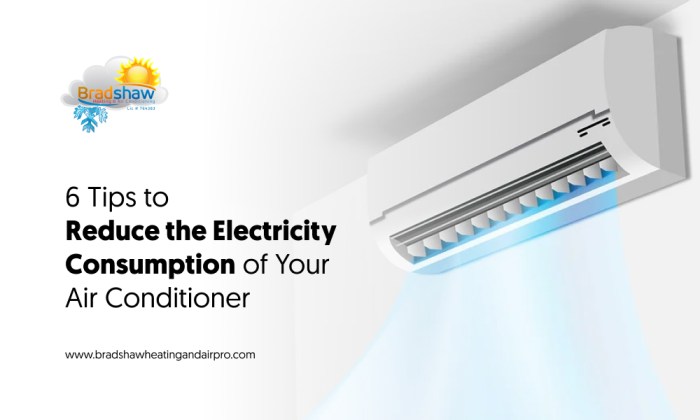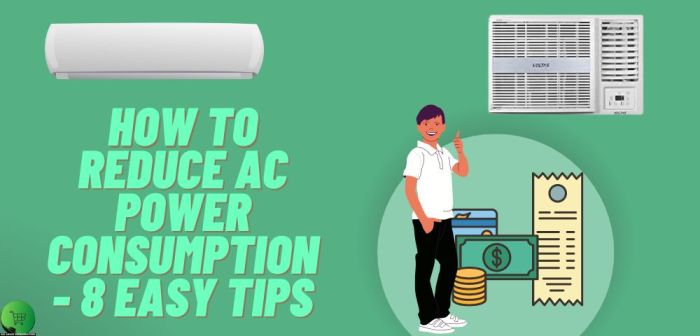How to reduce AC energy consumption starts with understanding the key factors that contribute to high energy usage in air conditioners. From optimal temperature settings to regular maintenance practices, this guide will provide actionable steps to help you lower your AC energy consumption effectively.
Learn about the impact of using fans and improving home insulation to create a more energy-efficient environment. By following these strategies, you can not only save on energy costs but also contribute to a greener lifestyle.
Understanding AC Energy Consumption

Air conditioners are essential for maintaining a comfortable indoor environment, but they can be significant energy consumers. Understanding the factors that contribute to high energy consumption in air conditioners is crucial for reducing energy costs and environmental impact.
One of the main factors that contribute to high energy consumption in air conditioners is the size of the unit relative to the space it is cooling. An oversized unit will cycle on and off more frequently, consuming more energy. On the other hand, an undersized unit will have to work harder to cool the space, also leading to increased energy consumption.
The components of an AC system that consume the most energy include the compressor and the fan. The compressor is responsible for cooling the refrigerant, while the fan circulates the air throughout the space. Both of these components require a significant amount of electricity to operate efficiently.
Energy efficiency ratings, such as SEER (Seasonal Energy Efficiency Ratio) for central AC systems, play a crucial role in determining the energy consumption of an air conditioner. Higher SEER ratings indicate a more energy-efficient unit that consumes less electricity to cool the same space compared to a unit with a lower SEER rating.
When comparing the energy consumption of different types of air conditioners, central AC systems tend to be more energy-efficient than split AC systems or window units. Central AC systems can cool larger spaces more efficiently, while split AC systems are more energy-efficient than window units due to their design and installation.
Factors Contributing to High Energy Consumption
- Size of the AC unit relative to the space it is cooling
- Efficiency of the compressor and fan components
- Insulation and sealing of the space being cooled
Energy Efficiency Ratings and Impact
- SEER ratings for central AC systems
- Energy Star certification for energy-efficient models
- Regular maintenance to improve energy efficiency
Comparison of Different AC Types
- Central AC systems
- Split AC systems
- Window AC units
Optimal Temperature Settings

Setting the thermostat to the optimal temperature can significantly reduce AC energy consumption. By following some simple guidelines, you can save energy and lower your electricity bills.
Adjusting temperature settings during the day and night can help save energy. During hot summer days, set the thermostat to a higher temperature when you are away from home or asleep. This can reduce the workload on the AC system and minimize energy usage. Similarly, during colder winter nights, lowering the thermostat a few degrees can also save energy without compromising comfort.
Impact of Programmable Thermostats, How to reduce AC energy consumption
Using programmable thermostats can have a positive impact on energy efficiency. These devices allow you to set specific temperature schedules based on your daily routine. For example, you can program the thermostat to automatically adjust the temperature when you are at work or asleep, reducing energy consumption when cooling or heating your home is not necessary.
Programmable thermostats can help you save energy by ensuring that your home is only being heated or cooled when needed. This can lead to significant energy savings over time, as the AC system operates more efficiently and does not waste energy by running unnecessarily. Additionally, some programmable thermostats offer features such as remote access and energy usage monitoring, allowing you to further optimize your energy consumption and reduce costs.
Regular Maintenance Practices

Regular maintenance plays a crucial role in reducing energy consumption and ensuring the optimal performance of an air conditioner. By following a routine maintenance schedule, you can improve the efficiency of your AC unit and prolong its lifespan.
Cleaning or Replacing Air Filters
Air filters in an air conditioner are responsible for trapping dust, dirt, and other particles from the air. Over time, these filters can get clogged, reducing the airflow and making the system work harder to cool the air. By regularly cleaning or replacing air filters, you can ensure proper airflow and improve energy efficiency. It is recommended to clean or replace filters every 1-3 months, depending on usage.
Importance of Professional AC Maintenance Services
While regular cleaning and maintenance tasks can be done by homeowners, it is also essential to schedule professional AC maintenance services at least once a year. A professional technician can thoroughly inspect and clean the various components of the air conditioner, including coils, fins, and ducts. They can also identify and address any potential issues that could affect the efficiency of the system. Professional maintenance not only improves energy efficiency but also helps prevent costly repairs in the future.
Improving Home Insulation: How To Reduce AC Energy Consumption

Proper insulation plays a crucial role in reducing the load on an air conditioner by creating a barrier that helps maintain a consistent indoor temperature. This can result in lower energy consumption and reduced strain on the AC unit.
Role of Windows, Doors, and Sealing Gaps
- Windows and doors are common areas where heat can enter or escape from a home. Ensuring that windows and doors are properly sealed can prevent hot air from entering during the summer months and cold air from coming in during the winter, reducing the need for the AC to work harder to maintain a comfortable temperature.
- Sealing gaps around windows, doors, and other openings in the home with weather stripping or caulking can significantly improve energy efficiency by preventing air leaks.
Benefits of Using Curtains or Blinds
- Installing curtains or blinds can help control the amount of sunlight entering a room, which can directly impact indoor temperature. During hot days, closing curtains or blinds can block out sunlight and heat, reducing the need for the AC to cool the space.
- Thick, insulating curtains can also provide an additional layer of insulation, helping to keep the indoor temperature stable and reducing the workload on the air conditioner.
Utilizing Fans and Ventilation
Utilizing fans and ventilation can be an effective way to reduce AC energy consumption in your home. Fans can help circulate cool air more efficiently, allowing you to set your AC at a higher temperature without sacrificing comfort. Natural ventilation techniques can also help cool your home without the need for air conditioning, further reducing energy usage. Maintaining proper airflow within the house is crucial for energy efficiency, as poor ventilation can lead to increased reliance on AC.
Using Ceiling Fans and Portable Fans
Using ceiling fans and portable fans strategically can help complement your AC usage. Ceiling fans can help distribute cool air more evenly throughout the room, allowing you to set your AC at a higher temperature. Portable fans can be used to create cross-ventilation by placing them near windows or doors to bring in fresh air from outside. This can help reduce the need for constant AC usage, ultimately saving energy and lowering your electricity bill.
Natural Ventilation Techniques
Natural ventilation techniques, such as opening windows and doors strategically, can help cool your home without relying heavily on air conditioning. By creating cross-ventilation and allowing fresh air to circulate throughout the house, you can maintain a comfortable indoor temperature without the need for continuous AC usage. Additionally, using exhaust fans in kitchens and bathrooms can help remove heat and humidity, improving overall airflow and reducing the workload on your AC system.
Importance of Airflow Maintenance
Maintaining proper airflow within your home is essential for energy efficiency. Blocked vents, dirty filters, or obstructed ductwork can restrict airflow and force your AC system to work harder to cool the space. Regularly cleaning and replacing filters, ensuring vents are unobstructed, and scheduling routine HVAC maintenance can help optimize airflow and reduce the energy consumption of your air conditioning system.
Concluding Remarks

In conclusion, reducing AC energy consumption is not just about cutting costs but also about making environmentally conscious choices. By implementing the tips Artikeld in this guide, you can achieve a more energy-efficient home while reducing your carbon footprint. Start saving energy and money today with these practical solutions.
Professional air conditioner maintenance services play a crucial role in ensuring the longevity and efficiency of your cooling system. By regularly scheduling maintenance with a reputable service provider like Professional air conditioner maintenance services , you can prevent costly repairs and breakdowns, as well as improve the overall performance of your AC unit.
If you want to maximize your air conditioner’s efficiency, there are several steps you can take. From cleaning or replacing air filters to sealing duct leaks, following the tips outlined in How to improve air conditioner efficiency can help you save money on energy bills and ensure your home stays cool and comfortable.
Calibrating your thermostat correctly is essential for optimizing your AC unit’s efficiency. By following the guidelines provided in How to calibrate thermostat for AC efficiency , you can ensure that your air conditioner operates at the ideal temperature settings, which can lead to significant energy savings and improved performance.